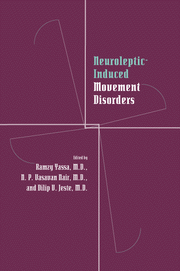Book contents
- Frontmatter
- Contents
- Contributors
- Preface
- Part I Historical perspective
- Part II Clinical aspects of tardive dyskinesia
- Part III Mechanisms underlying tardive dyskinesia
- 11 Neurochemistry of the basal ganglia
- 12 A reanalysis of the dopamine theory of tardive dyskinesia: the hypothesis of dopamine D1/D2 imbalance
- 13 Tardive dyskinesia and phenylalanine metabolism: risk-factor studies
- 14 Neuroendocrinological studies of tardive dyskinesia
- 15 Cognitive deficits and tardive dyskinesia
- 16 Studies of tardive dyskinesia using computed tomography and magnetic-resonance imaging
- 17 Rodent and other animal models of tardive dyskinesia during long-term neuroleptic-drug administration: controversies and implications for the clinical syndrome
- Part IV Measurement of tardive dyskinesia
- Part V Tardive dyskinesia in different populations
- Part VI Other neuroleptic-induced movement disorders
- Part VII Treatment of tardive dyskinesia
- Index
17 - Rodent and other animal models of tardive dyskinesia during long-term neuroleptic-drug administration: controversies and implications for the clinical syndrome
from Part III - Mechanisms underlying tardive dyskinesia
Published online by Cambridge University Press: 09 October 2009
- Frontmatter
- Contents
- Contributors
- Preface
- Part I Historical perspective
- Part II Clinical aspects of tardive dyskinesia
- Part III Mechanisms underlying tardive dyskinesia
- 11 Neurochemistry of the basal ganglia
- 12 A reanalysis of the dopamine theory of tardive dyskinesia: the hypothesis of dopamine D1/D2 imbalance
- 13 Tardive dyskinesia and phenylalanine metabolism: risk-factor studies
- 14 Neuroendocrinological studies of tardive dyskinesia
- 15 Cognitive deficits and tardive dyskinesia
- 16 Studies of tardive dyskinesia using computed tomography and magnetic-resonance imaging
- 17 Rodent and other animal models of tardive dyskinesia during long-term neuroleptic-drug administration: controversies and implications for the clinical syndrome
- Part IV Measurement of tardive dyskinesia
- Part V Tardive dyskinesia in different populations
- Part VI Other neuroleptic-induced movement disorders
- Part VII Treatment of tardive dyskinesia
- Index
Summary
The prominence of tardive dyskinesia in some patients, juxtaposed against the difficulty of developing a valid (i.e., behaviorally homologous and pharmacologically isomorphic) animal model for this clinical syndrome, provides one of today's greater contradictions in neuroleptic psychopharmacology. It should be emphasized that conceptually, seeking such models for tardive dyskinesia – in terms of late-onset, usually orofacial, movements that emerge during very long term treatment with neuroleptic drugs – differs greatly from seeking to clarify the consequences of that treatment at the level of dopaminergic neurotransmission. In the latter situation, any relationship to tardive dyskinesia is indirect. Indeed, the well-established changes in neuronal function, such as striatal dopamine-receptor sensitivity, have been widely reported to occur in the absence of spontaneous behaviors akin to those of the clinical disorder whose putative pathophysiology is supposedly reproduced (Waddington, 1989, 1990).
The rodent studies of the 1980s – the first decade during which the attempt to find behavioral homology, as opposed to purported pathophysiology, was examined – have been reviewed elsewhere (Waddington, 1990). Among 21 relevant studies of orofacial function in rats administered neuroleptic drugs for substantial proportions of their adult lives, many showed late-onset oral movements, although no such effects (or sometimes even a very early onset of such movements) were apparent in others. To some extent, the phenomenology, pharmacologic characteristics, and pathophysiology of these late-onset movements paralleled clinical tardive dyskinesia, although a careful consideration of the methodological factors did not resolve the apparent inconsistencies (Waddington, 1990).
- Type
- Chapter
- Information
- Neuroleptic-induced Movement DisordersA Comprehensive Survey, pp. 225 - 238Publisher: Cambridge University PressPrint publication year: 1996
- 2
- Cited by



